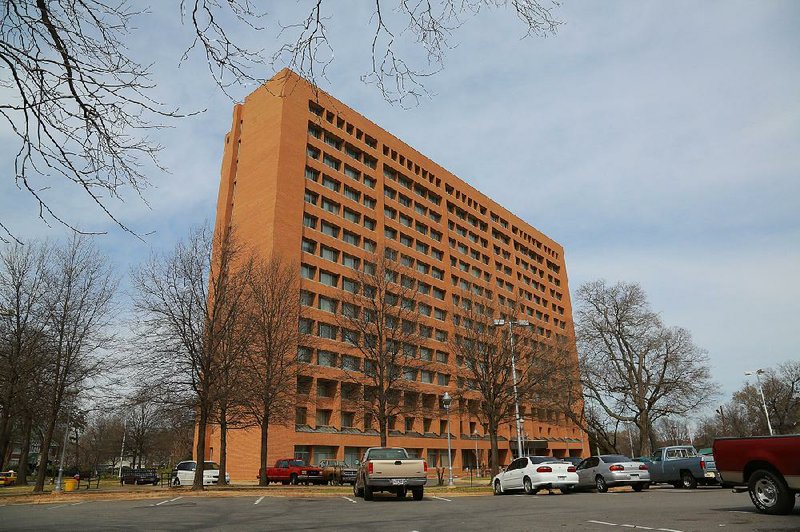Little Rock's public housing agency plans to start multimillion-dollar renovations at its downtown housing towers at the start of 2018.
The redevelopment of 597 units coincides with a change in how public housing in Arkansas' capital city is administered. The three downtown buildings -- Fred W. Parris, Cumberland and Jesse Powell towers -- will switch from public housing to Section 8 properties involving a private investor under a new federal program.
The U.S. Department of Housing and Urban Development's Rental Assistance Demonstration program loosens financial restrictions on public housing agencies like Little Rock's Metropolitan Housing Alliance, the largest in the state.
The shift is expected to free up funds beyond the federal government's yearly allotment of capital improvement dollars -- about $1 million annually for Little Rock -- to update and repair properties. Fixing the three towers alone is projected to cost more than $50 million.
Tenants may be asked to move into different units temporarily while theirs are renovated, but their finances should remain unaffected, officials said. The tenants will be transferred over to HUD's Section 8 rental-subsidy program.
"It's just a program change for us," said Rodney Forte, Metropolitan Housing Alliance's executive director. "Nothing changes for the tenant."
The same transition taking place in Little Rock is occurring in public housing agencies across the state and nation. By partnering with private-sector entities, housing agencies have found a way to offset cuts in federal funding at a time when many public housing buildings are starting to crumble.
Little Rock housing officials estimate the Rental Assistance Demonstration program could inject more than $100 million into the local economy.
Wisconsin-based Gorman and Company Inc., a development and investment company, will own the three housing towers, but it plans to use local sub-contractors for as much renovation work as possible, Forte said.
Company officials didn't return phone messages requesting comment last week.
On Tuesday, Gorman and the housing agency will host a one-hour "pre-bid information session" for local trade professionals at noon at Parris Towers, 1800 Broadway.
Bids will be solicited from contractors, vendors and providers of demolition, abatement, cabinetry, flooring, plumbing, electrical, roofing, heating and air, painting, carpentry, pipe fitting, sheet metal, masonry, landscaping, movers, boilermakers, drywall, insulation and sprinklers, the agency said. Construction bidding opens Oct. 3 and closes Oct. 31.
Officials plan to fix up Parris Towers first. Then it will proceed with renovations at Cumberland Towers, 311 E. Eighth St., and Jesse Powell Towers, 1010 Wolfe St.
The towers stopped leasing units in March to clear floors for the coming construction work.
The towers will be the Little Rock housing agency's second group of properties transferred to the Rental Assistance Demonstration program but the first undergoing large-scale renovations.
The agency converted Cumberland Manor and Metropolitan Village -- both on South Scott Street -- in July. Both 60-unit properties were constructed in 2009, so no repairs were needed, the agency said.
After the three downtown towers' rehabilitation is complete, the agency will shift its focus to converting Madison Heights, 1401 Madison St., to the Rental Assistance Demonstration program, followed by the Homes at Granite Mountain, 6 Harris St., and Sunset Terrace, 2800 Battery St.
No tenant will see rent increases as a result of Rental Assistance Demonstration conversion, officials said, and the agency expects to complete all conversions by January 2020.
The Metropolitan Housing Alliance's properties are among 3,000 in 11 Arkansas cities that have converted or plan to convert to the new program, which was formed in 2012.
Statewide, Arkansas has 27,000 people living in 14,000 public housing units.
The Fort Smith Housing Authority was the first public housing agency in Arkansas to enroll in the Rental Assistance Demonstration program three years ago.
Officials in Fort Smith and Paragould, whose housing authority also switched, have said their conversions freed the agencies from HUD's vast web of regulations.
Elsewhere in the U.S., a 206-unit apartment complex in Lexington, Ky., which is slightly larger than Little Rock, underwent rehabilitation under the Rental Assistance Demonstration program last year.
That project utilized similar funding mechanisms as the planned Little Rock towers renovations, and a HUD review deemed it a success.
Lexington officials had been exploring demolishing the property because of inadequate capital improvement funds, but the conversion program opened several funding avenues that weren't available under HUD's traditional regulations, officials said.
All three of Little Rock's downtown public housing towers were built in the early 1970s as part of a federal policy shift aimed at increasing public housing for senior citizens.
The cost to develop each tower ranged from about $3 million to $4.4 million at the time, and they were modeled after Victoria Plaza in San Antonio. The idea was to provide efficiency and one-bedroom units in a single high-rise tower surrounded by green space.
They were constructed strategically in residential areas on the outskirts of downtown, so residents would be near social services and resources.
The three towers were the only ones built in Little Rock before former President Richard Nixon's administration placed a moratorium on new construction in 1973 to shift federal policy toward housing vouchers.
The towers were placed on the National Register of Historic Places in March, making the buildings eligible for for the National Park Service's Historic Tax Credit. The credit is worth about $1.8 million per property.
The towers' designations on the National Register of Historic Places -- the federal government's official list of sites worth preserving -- was first denied by the Arkansas Historic Preservation Review Board in December. However, Department of Arkansas Heritage Director Stacy Hurst recommended the proposals to the National Park Service after her own review.
A Section on 09/18/2017

